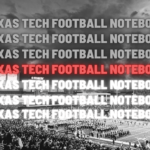I’ve been thinking a lot about the situation regarding the transfer portal and the tremendous success that Texas Tech has had in recruiting and signing players in the transfer portal.
I mentioned a week ago that this felt like that Cody Campbell and the Texas Tech football staff knew that there was going to be an opening, an opportunity that was going to have a very short window and it would have been incredibly important to capitalize on this moment. It’s been noted that The Matador Club is set to cease operations in July of 2025, which seems insane to consider that this entity that’s set to terminate in July because it will have served its purpose. That’s the first thing to understand.
The second item that’s important is that what will happen next is that Texas Tech and I think any program that will participate will be subject to the salary cap after July 1st, which will be instituted moving forward. I think this also means that future NIL deals will be subject to review by athletic departments (and maybe the NCAA including the accounting firm Deloitte), in other words the NIL deal will need to be similar to the service provided by the student-athlete. So the idea of payment that’s not within the salary cap figure will not be permitted, thus, what’s happening with The Matador Club is a bit singular. But even that will likely subject to lawsuits and the idea of determining “fair market value” and whether or not something is an associated entity will likely prove incredibly problematic for the NCAA. The party will likely not stop. At least for now, we know what we have until July.
If the House settlement is approved & schools are capped on how much they can pay athletes, 3rd party NIL $ will be a recruiting differentiator.
But there’s confusion on how 3rd party NIL deals will be viewed under the model envisioned by the settlement.
So let’s take a look. pic.twitter.com/kewbs5k1cS
— Mit Winter (@WinterSportsLaw) December 29, 2024
Whatever one might think about the House v. NCAA settlement, the NCAA retaining an accounting firm to determine the FMV value of college athletes (
) is nothing short of an invitation for wealthy donors to sue the NCAA for illegal interference with their third-party NIL deals. https://t.co/9D0KJhvUpH
— Tom Mars (@TomMarsLaw) December 30, 2024
Texas Tech has this year to take advantage a free-for-all where The Matador Club could pay whatever they want for a player without a cap and the hope that this then springboards Texas Tech moving forward.
In the article linked below, Cody Campbell said that there are 4 things that drove the success of Texas Tech in the transfer portal:
1. Complete alignment among coaches, boosters and administrators.
2. The ability to move quickly to get deals done.
3. The recruiting prowess of McGuire and his general manager, James Blanchard.
4. The sums of money Tech can bring to the table.
The article (again, linked below) said that when a player commits, Cody Campbell and The Matador Club have attorneys on staff to send a contract to the agent within the hour so they can make it official. Efficiently working.
The biggest two questions I have are as follows and I think we have to wait the season to play out: 1) how well did the staff scout players; and 2) how well can Joey McGuire create a team rather than a collection of players looking to get a bag of money. Those answers will play out over the course of 2025 and I am sure that we will have many discussions between now and then.
And on December 21st, Cody Campbell was on with Thetford & Ashby where he all but confirmed the idea of capitalizing on a market that had a one-year window, and he also mentioned that the lawsuits that would result if the SEC and Big Ten wanted to take their toys and go home would likely result in significant lawsuits. It’s a 30-minute listen, but worth it if you want to hear Campbell discuss a lot of this.
 The Athletic’s Sam Kahn ($) on how Texas Tech was able to pull off the best transfer portal class this year. There is a lot of detail and it basically comes down to the idea that The Matador Club is run like one of Cody Campbell and John Sellers’ businesses, contracts and attorneys ready, the money is available, and payments do not get missed.
The Athletic’s Sam Kahn ($) on how Texas Tech was able to pull off the best transfer portal class this year. There is a lot of detail and it basically comes down to the idea that The Matador Club is run like one of Cody Campbell and John Sellers’ businesses, contracts and attorneys ready, the money is available, and payments do not get missed.
“This is what we do every day. We go out and acquire properties and we do deals. … And so we set up the Matador Club the same exact way. A lot of times the most efficient, the most nimble group wins, and that’s what we’ve aimed to do here.”
James Blanchard, Texas Tech’s general manager, and the scouting staff started scouting in January, every FBS starter and the top FCS players, files were collected on players and ranked:
The staff ranked its 100 top offensive and defensive linemen, then cross-checked game tape from this season once it became available. For well-stocked personnel departments, it’s standard practice ahead of the December portal window
“A lot of it was a waste of time because 80 percent of these guys don’t get in the portal,” Blanchard said. “But the 20 percent that do, you’ve already got it done … and your plan of attack is that much further ahead.”
When players have visited campus, Tech has used traditional recruiting strategies: pristine facilities and personal relationships. The school opened its $242 million south end zone renovation at Jones AT&T Stadium, which includes all the coaches’ offices, meeting rooms, a new game day locker room, suites and a club area. The Womble Football Center, the team’s daily operations headquarters, was also part of that pricey face-lift, paid for by Tech donors.
 ESPN’s Max Olson gets into the winners and losers of the portal with a very positive view of Texas Tech’s haul:
ESPN’s Max Olson gets into the winners and losers of the portal with a very positive view of Texas Tech’s haul:
Key additions: DT Lee Hunter (UCF), OL Howard Sampson (North Carolina), OL Hunter Zambrano (Illinois State), OLB Romello Height (Georgia Tech), WR Reggie Virgil (Miami [Ohio])
Texas Tech is trying to win the Big 12 and get into the College Football Playoff in 2025, and its acquisitions in December prove the Red Raiders are serious about those ambitions. The trio of Texas Texas coach Joey McGuire, GM James Blanchard and megadonor Cody Campbell are going out and getting who they want, unafraid to make strong six- and seven-figure offers to lock up the players at the top of their board.
Their all-in shove after an 8-5 season is yielding legitimate future NFL talent. Hunter is the No. 2 defensive tackle and Sampson is the No. 2 offensive tackle in ESPN’s transfer rankings. Zambrano, Height, Miami (Ohio) tackle Will Jados and Northern Illinois defensive tackle Skyler Gill-Howard are one-year pickups and valuable upgrades up front. Texas Tech beat Florida and Oklahoma for Virgil, added USC transfer running back Quinten Joyner to help replace the production of Tahj Brooks and got Louisiana’s Terrance Carter, one of the top tight ends in the portal, to take over for Jalin Conyers.
Newly hired Texas Tech defensive coordinator Shiel Wood has been able to quickly rebuild the Red Raiders’ secondary with Cole Wisniewski (North Dakota State), Brice Pollock (Mississippi State), Amier Boyd-Matthews (UTEP), Tarrion Grant (Purdue) and Dontae Balfour (Charlotte) all on the way.
 CBS Sports’ John Talty & Chris Hummer go on a deep dive into how this whole transfer portal works, from the money, to the deals, to the confirmation that there is a reason why Cody Campbell and The Matador Club are spending money:
CBS Sports’ John Talty & Chris Hummer go on a deep dive into how this whole transfer portal works, from the money, to the deals, to the confirmation that there is a reason why Cody Campbell and The Matador Club are spending money:
Collectives can currently raise money and spend with almost no oversight. Those $20 million budgets in places like Ohio State are still in operation. In six months schools will have a new bundle of cash to use — likely around $15 million for most Power Four football programs — via the House settlement. If every Power 4 school plus Notre Dame fully funds revenue sharing for football, it would likely total more than $1 billion in spending.
Thus, two things are happening in concert that help explain the spike:
1. Schools that didn’t have much NIL money before are using their future rev share allotment to spend big.
2. Schools with large collective budgets are spending their annual allotment now before the House rules on fair market value go into effect. NIL deals in the post-House era will be filtered through a clearinghouse to determine if the contract meets a still-to-be-determined market standard. In other words, players will actually have to earn their NIL money instead of it being used as a pseudo-salary.
“If you want to use that money the way you have in the past, you have to pay a lot of it before July 1,” said NIL attorney Mit Winter, who works with several collectives. “Or even all of it.”
That’s how $5 million budgets become $15 million and $10 million can become $25 million in a few short months. The schools that are double-dipping, particularly, are driving up the market.
They’ve got cash to burn.
“They’re looking to do as much as they can to deplete those budgets between January and June so those dollars won’t count towards the cap,” said Opendorse President of Collegiate Operations, Blake Lawrence, whose NIL platform works with 100-plus Division I schools.
 Lubbock Avalanche-Journal’s Don Williams also dives into the details regarding the Alston award payments, which were payments that student-athletes received, and that in the future, those student-athlete will receive an NIL contract for the minimum of the Alston award amount, which was $5,980 per year (this is a minimum so I am sure more money will be given out).
Lubbock Avalanche-Journal’s Don Williams also dives into the details regarding the Alston award payments, which were payments that student-athletes received, and that in the future, those student-athlete will receive an NIL contract for the minimum of the Alston award amount, which was $5,980 per year (this is a minimum so I am sure more money will be given out).
 CONFIRMED (17):
CONFIRMED (17):
+ OT Howard Sampson (6-8/325) North Carolina
+ OT Hunter Zambrano (6-5/305) Illinois State
+ OT Will Jados (6-8/307) Miami (Ohio)
+ WR Reggie Virgil (6-4/190) Miami (Ohio)
+ TE Terrance Carter, Jr. (6-2/239) Louisiana
+ RB Quinten Joyner (5-11/216) USC
+ QB Mitch Griffis (5-11/193) Wake Forest
+ DT Skyler Gill-Howard (6-2/285) Northern Illinois
+ DT Lee Hunter (6-4/320) UCF
+ DT Anthony Holmes, Jr. (6-2/295) Houston
+ OLB Romello Height (6-3/240) Georgia Tech
+ CB Brice Pollock (6-1/190) Mississippi State
+ CB Amier Boyd-Matthews (6-1/180) UTEP
+ CB Tarrion Grant (6-2/197) Purdue
+ CB Dontae Balfour (6-2/185) Charlotte
+ S Cole Wisniewski (6-4/218) North Dakota State
+ K Upton Bellenfant (6-2/180) Buffalo
HIGH SCHOOL:
+ Frenship QB Holden Phillips (6-1/190)
 Current transfer portal team rankings:
Current transfer portal team rankings:
Rivals: 3 (2 in Big 12)
24/7 Sports: 1 (1 in Big 12)
On3: 2 (1 in Big 12)
Rankings are typically pretty fickle and as you’ll note, other than Texas Tech and Kansas, there’s a pretty wild variance between a handful of teams, but to be the best means that something was done right. As an aside, this was done on December 23rd, so there may have been some movement, but at the very least, this was a snapshot as of that time.
| Team | Rivals | 24/7 | On3 | Average |
|---|---|---|---|---|
| Texas Tech | 1 | 1 | 1 | 1.00 |
| Kansas | 2 | 3 | 2 | 2.33 |
| Colorado | 3 | 2 | 10 | 5.00 |
| Houston | 7 | 5 | 3 | 5.00 |
| Baylor | 8 | 8 | 4 | 6.67 |
| Arizona | 5 | 6 | 13 | 8.00 |
| Oklahoma State | 4 | 7 | 14 | 8.33 |
| Cincinnati | 6 | 10 | 9 | 8.33 |
| Utah | 10 | 4 | 12 | 8.67 |
| Arizona State | 12 | 13 | 5 | 10.00 |
| TCU | 14 | 11 | 7 | 10.67 |
| Kansas State | 13 | 14 | 6 | 11.00 |
| UCF | 9 | 9 | 16 | 11.33 |
| Iowa State | 11 | 12 | 11 | 11.33 |
| BYU | 16 | 15 | 8 | 13.00 |
| West Virginia | 15 | 16 | 15 | 15.33 |









